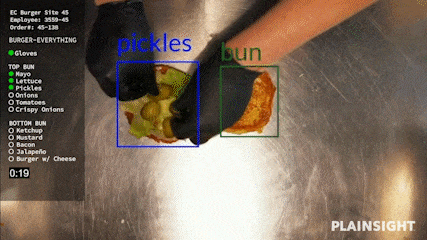Computer Vision Redefines Service Excellence for the Restaurant Industry
Welcome back to our blog series on computer vision solutions tailored to augment the workforce’s capabilities, maximize efficiency, and build the enterprises of the future. In Part 1, we explored the ways computer vision is helping agribusinesses see what’s next and evolve legacy processes without displacing farmers and ranchers. This time around, we’re looking at computer vision-enabled innovation in restaurants.
Plainsight’s team is ushering restaurants into an era of digital transformation with solutions for drive-thru monitoring, order accuracy assessment, and more. Though the conversation around emerging solutions can have a fearful tone, effectively deployed computer vision augments the workforce rather than replacing it. Transformational in its benefits, computer vision shows how AI is capable of empowering workers and evolving jobs to boost employee satisfaction.
Case Study: Reducing Burnout without Reducing Headcount
Plainsight’s engagement with a large, North American restaurant chain, in partnership with World Wide Technology (WWT), Intel, and Google Cloud offers a powerful example of computer vision’s potential to fundamentally transform the way kitchens are operated without eliminating employees.
Historically, the chain relied on managers to look at its buffet containers and make on-the-fly predictions to direct kitchen activity. Needless to say, it wasn’t a perfect process. It often resulted in periods of unavailability for popular dishes and always added additional stress for employees.
At first, the restaurant looked to address the issue by adding weight sensors to its buffet lines. This was only a slight improvement. While weight sensors promised accurate readings capable of optimizing kitchen strategy to better serve hungry customers, they were poorly suited to a production setting. In a crowded, busy restaurant, scales constantly needed to be cleaned and recalibrated to ensure accurate readings. It only wound up introducing new headaches for the already-overworked restaurant staff.
Through WWT, the restaurant engaged Plainsight to solve the problem with computer vision. Using the weight data the restaurant had already collected as ground truth, we were able to build and train a regression model for predicting the weight of dishes on the buffet line in real time and automating alerts to guide kitchen activity.
In just 22 days, our solution could predict the remaining quantity of a dish with a single-scoop margin of error. That, plus instant alerts to kitchen staff, provided for a less hectic work environment and a more satisfying customer experience. The chain is now poised to introduce this and additional solutions to its locations across the country.
Getting the Most from Vision AI
An insufficient emphasis on transparency has contributed to both misgivings about AI’s increasing capabilities and the fact that a majority or organizations are still seeing disappointing results. In their latest State of AI in the Enterprise report, Deloitte found that while the number of organizations who had successfully deployed several AI solutions had increased, the number of self-reported “underachievers” had increased since 2021 as well.
Adoption rates and overall results both improve when leaders make an effort to establish an AI-ready culture within their enterprises before committing to projects. What does an AI-ready culture look like? Deloitte notes that such a culture is defined by trust, transparency, open lines of communication, and thorough education on both how to leverage AI-powered solutions and how these solutions make life easier.
This type of education, an emphasis on the how and why of computer vision initiatives, is generally lacking within enterprises. Just 21% of survey respondents reported taking the time to instruct their teams on how to deploy AI most effectively and only around a third reported including end users in the process of designing solutions. These measures can go a long way in addressing AI-centric fears, improving implementation rates, and accelerating proof of value.
More Restaurant Use Cases
Automated food quantity measurement is just a taste of how computer vision is transforming day-to-day operations for restaurants and their employees. From Quick Service Restaurants, to Fast Casuals, to fine dining establishments, the industry is seeing the value of vision AI:
- Drive-thru monitoring and performance management: How long will customers wait before they abandon their orders? What times see the most drive-thru traffic? Models for monitoring and managing drive-thrus offer these insights and more, helping restaurants make the most of high demand and continually redefine service excellence.
- Healthy and safety monitoring: Personal protective equipment and safety regulations help keep your restaurants productive, orderly, and clean. Plainsight’s custom-built models enforce health and safety standards round the clock with automated alerts and an unblinking eye.
- Order quality and accuracy assurance: Hungry customers expect a dependable product every time. Models for monitoring kitchen activity help ensure every item is prepared quickly and meets precise quality specifications.
Interview: Transforming Restaurants with Computer Vision
In a recent interview with Restaurant Technology News, our Co-Founder and CEO, Carlos Anchia, discusses Plainsight’s work to empower the restaurant workforce by arming enterprises with purpose-built, scalable vision AI solutions:
“Our solutions help automate and optimize a number of processes to decrease workloads for employees who already have a lot on their plates. The insights restaurants can obtain from real-time video analytics inform better decision making so employees can focus on more high-impact, enjoyable aspects of their roles–the ones that make them feel like a part of a team. With time, the benefits of automating processes with speed and accuracy increases job satisfaction and decreases turnover.”
Read the full conversation to learn more about how computer vision is serving as a catalyst for holistic innovation and helping restaurants of all types address challenges like rising demand, employee turnover, and a crowded competitive landscape.
See More
Next week, we’ll take a look at how computer vision solutions are powering digital transformations for retailers. In the meantime, schedule a call with Plainsight’s team to learn more about how the leaders in enterprise vision AI can support you.
You May Also Like
These Related Stories

Computer Vision-Enabled Restaurants: The Recipe for Super-Sized Innovation
.png)
No Comments Yet
Let us know what you think